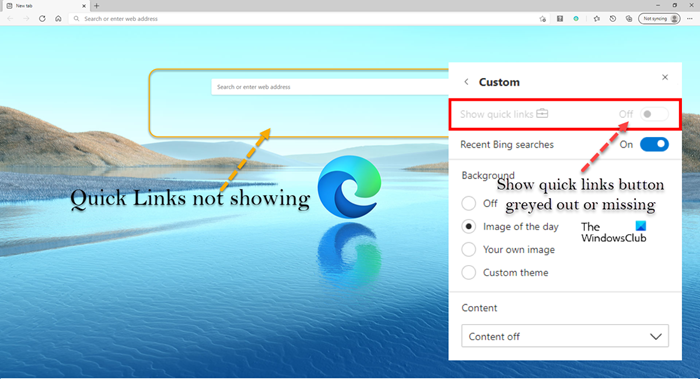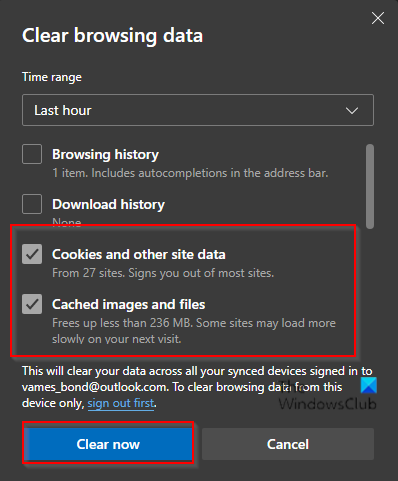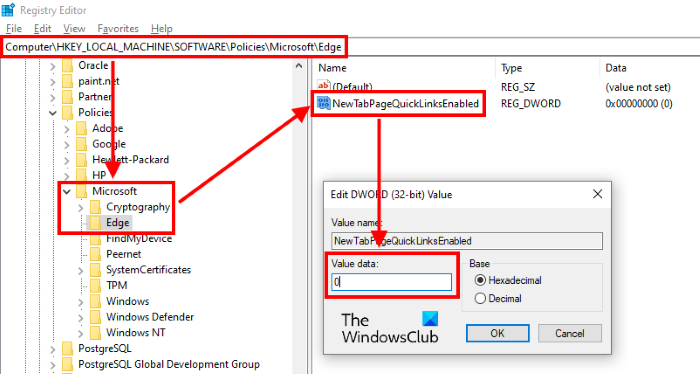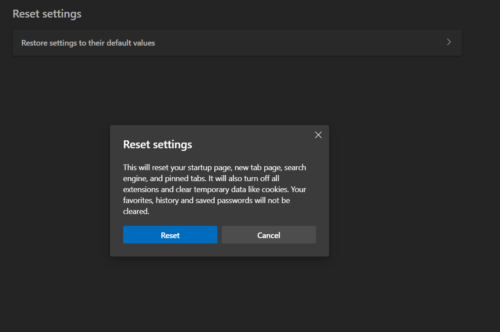If you fire up the Edge browser on your Windows 11 or Windows 10 PC, you may notice on the new Tab page that Quick Links is not showing. In some reported cases, the toggle On/Off button for the option to Show quick links is either missing or greyed out in the browser Settings page. This post offers applicable fixes to this issue.

Quick Links not showing or Button missing or greyed out in Edge
If you’re unable to add Quick Links or it’s not showing up on the new Tab page or the Show quick links toggle On/Off button is missing or greyed out in the Edge browser Settings page on your Windows 11/10 PC, then our recommended fixes presented can be easily applied to resolve the issue.
- Initial checklist
- Clear cache/cookies and Disable extensions in Chrome
- Modify the Windows Registry
- Reset Edge to default settings
- Reinstall the Edge browser
Let’s see these suggested fixes in detail.
1] Initial checklist
Make sure Edge is updated to the latest build/version as the Quick Links not showing or the button missing or greyed out in the browser Settings could be due to a bug. In addition, before you proceed, for some affected Edge browser users on PC, what worked as a quick workaround for them when first the browser is launched and the Quick Links aren’t there or showing — you will have to manually disable then re-enable them (that is toggling the Show quick links button to Off, then On) to get them to show as in this case, it appears to be a temporary glitch. However, in the case where the button is either missing or greyed out, then you can continue with the rest of the solutions offered in this post.
Read: Microsoft Edge not restoring previous Tab session
2] Clear cache/cookies and Disable extensions in Edge

We cannot overrule the possibility that the issue you are currently facing isn’t due to a corrupted cache or browsing data or an outdated or incompatible browser extension. In this case, you can clear the cache and cookies on the Edge browser, then relaunch the browser and see if the issue is resolved. Similarly, if you have dozens of Edge or third-party extensions installed, you will need to disable all extensions and then enable them one after the other in between checking if the Quick Links not showing or the button missing or greyed out the issue in Edge is resolved. Once you determine the culprit, you can update the extension and see if that fixes the problem, otherwise, leave the extension disabled.
3] Modify the Windows Registry

If the Show quick links toggle On/Off button is missing, then it could be that the registry key NewTabPageQuickLinksEnabled is not present on the system or the value is set to 0 which will hide the Quick Links menu from the Edge new Tab page permanently. In this case, to resolve the issue, you will need to create/modify the registry key in reference and set its value to 1.
Since this is a registry operation, it is recommended that you back up the registry or create a system restore point as necessary precautionary measures. Once done, you can proceed as follows:
- Press the Windows key + R to invoke the Run dialog.
- In the Run dialog box, type regedit and hit Enter to open Registry Editor.
- Navigate or jump to the registry key path below:
HKEY_LOCAL_MACHINE\SOFTWARE\Policies\Microsoft\Edge
- At the location, on the right pane, double-click the NewTabPageQuickLinksEnabled entry to edit its properties.
If the key is not present, right-click on the blank space on the right pane and then select New > DWORD (32-bit) Value to create the registry key, and then rename the key accordingly and hit Enter.
- Double-click on the new entry to edit its properties.
- Input 1 in the Value data field.
- Click OK or hit Enter to save the change.
- Exit Registry Editor.
- Restart your PC.
On boot, launch Edge and check if the issue is resolved. Alternatively, you can create and use a REG file to enable the registry key using the code below:
Windows Registry Editor Version 5.00 [HKEY_LOCAL_MACHINE\SOFTWARE\Policies\Microsoft\Edge] "NewTabPageQuickLinksEnabled"=dword:00000001
Simply copy and paste the code into Notepad, then save the file with a .reg extension, then run the file to merge it to the registry. Similarly, you can achieve the same outcome by adding and enabling the registry key in reference by editing the registry via Command Prompt. To perform this task, simply open the CMD prompt in admin mode and then run the command below:
reg.exe Add "HKLM\Software\Policies\Microsoft\Edge" /V "NewTabPageQuickLinksEnabled" /T REG_DWORD /D "1"
- Exit CMD prompts once the command executes.
4] Reset Edge to default settings

When you reset the Edge browser, it will reset the start-up page, new tab page, search engine, and pinned tabs. It will also disable all extensions and clear temporary data such as cookies. Your favorites, history, and saved passwords will not be cleared. But before you reset Microsoft Edge, make sure you have backed up or synchronized your local data like passwords, favorites, profiles, and anything else you don’t want to lose.
5] Uninstall the Edge browser
This should be your last-ditch effort to resolve the issue at hand. If you’re having issues with Edge, you should be able to get the browser to normal working conditions by performing either a reset or repair. But in the rare cases where neither works, you can try to uninstall Edge. But before you proceed with this task, make sure you have another browser installed on your Windows 11/10 PC and create a system restore point.
To uninstall and then install Edge on your device, follow these steps:
- Press the Windows key + E to open File Explorer.
- Navigate to the directory path below:
C:\Program Files (x86)\Microsoft\Edge\Application
- At the location, double-click on the folder with the browser version number.
- Next, double-click the Installer folder.
- Now, to copy the location from the File Explorer address bar, press Alt+D, then press CTRL+C.
- Next, run the command below in Command Prompt elevated mode to navigate to the folder containing the setup.exe file for the Edge browser. Substitute the <Location> placeholder with the path copied from the File Explorer address bar.
cd /d <Location>
- Now, copy and paste the command below and hit Enter to force-uninstall Edge on your device:
.\setup.exe -uninstall -system-level -verbose-logging -force-uninstall
- When done you can exit File Explorer and CMD prompt.
Alternatively, copy and paste the command below in the elevated CMD prompt and hit Enter:
cd %PROGRAMFILES(X86)%\Microsoft\Edge\Application\9*\Installer
Similarly, to achieve the same outcome, you can copy your Edge version from the browser About page by clicking the Settings and more menu icon > Help and feedback > About Microsoft Edge. Then execute the following command in the elevated CMD prompt. Replace the <YourEdgeVersion> placeholder with the version number you copied previously.
cd %PROGRAMFILES(X86)%\Microsoft\Edge\Application\<YourEdgeVersion>\Installer
Once the command executes, copy and paste the following command and hit Enter:
setup.exe –uninstall –force-uninstall –system-level
Once you have completed the uninstall procedure, to reinstall Edge on your device, download Edge’s latest version from the official page, then run the setup file and follow the on-screen directions to complete the installation.
I hope this helps!
Now read: New Tab Customize Option missing in Microsoft Edge
Why did some of my shortcuts disappear?
If some of your desktop shortcuts or icons have disappeared on your Windows 11/10 PC, it’s possible that your desktop icon visibility settings were toggled off, which caused them to disappear. This issue can be due to human error or caused by an application you recently used or installed. To resolve the issue, unhide the desktop icons on your device.
Why is my Quick Access toolbar not showing?
If you don’t see the Quick Access toolbar in your Office program, you may need to simply customize the Quick Access toolbar. To do this, open the Office suite software, then go to File > Options > Quick Access Toolbar. At the bottom of the resulting window make sure the box is checked for the option to Show Quick Access Toolbar. Below that you can choose to show the toolbar position above or below the Ribbon.